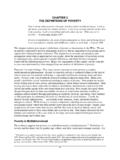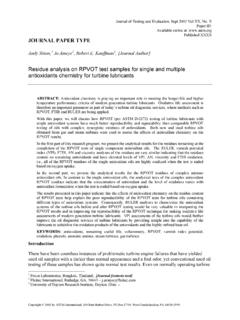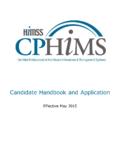Transcription of Introduction to the Insurance Industry - World Bank
1 Introduction to the Insurance Industry Rodney Lester primer series on Insurance issue 1, march 2009. 1-2 2/9/09 15:27:02. Introduction to the Insurance Industry Rodney Lester primer series on Insurance issue 1, march 2009. ii Introduction to the Insurance Industry THIS ISSUE. Author Rodney Lester is is a senior advisor at the World Bank with global experience in Insurance development and supervision, and 30 years of experience in the private sector Insurance and fund management industries. Before joining the World Bank he was a Managing Director in AMP, Australia's largest non-bank financial institution with responsibility for Insurance businesses in Australia, New Zealand and the UK. During this time he served as President of the Insurance Council of Australia. He has also been CEO of a number of medium-sized diversified financial services groups operating in all areas of the Insurance and funds management industries and in leasing. At the World Bank, his activities have included pensions and Insurance Industry reform and resolution work, development of private pension mechanisms, natural disasters funding, corporate governance and microinsurance.
2 Series editor Rodolfo Wehrhahn is a senior Insurance specialist at the World Bank. He joined the Bank in 2008 after 15 years in the private reinsurance and Insurance sector and 10 years in academic research. Before joining the World Bank, he served as President of the Federation of the Interamerican Insurance Associations representing the American Council of Life Insurers. He was board member of the AEGON Insurance and Pension Companies in Mexico, and was CEO of reinsurance operations for Latin America for Munich Reinsurance and for AEGON. For questions about this primer, or to request additional copies, please contact: The Primer Series on Insurance provides a summary overview of how the Insurance Industry works, the main challenges of supervision, and key product areas. The series is intended for policymakers, governmental officials, and financial sector generalists who are involved with the Insurance sector. The monthly primer series, launched in February 2009 by the World Bank's Insurance Program, is written in a straightforward, non-technical style to share concepts and lessons about Insurance with a broad community of non-specialists.
3 2008 The International Bank for Reconstruction and Development/The World Bank 1818 H Street, NW. Washington, DC 20433. Internet: E-mail: All rights reserved. First printing March 2009. This volume is a product of the staff of the International Bank for Reconstruction and Development/The World Bank. The findings, interpretations, and conclusions expressed in this paper do not necessarily reflect the views of the Executive Directors of The World Bank or the governments they represent. The World Bank does not guarantee the accuracy of the data included in this work. The boundaries, colors, denominations, and other information shown on any map in this work do not imply any judgement on the part of The World Bank concerning the legal status of any territory or the endorsement or acceptance of such boundaries. Cover and publication design: James E. Quigley Cover illustration: Imagezoo/Corbis Introduction to the Insurance Industry iii Contents The nature and history of 1. Role of government in 3.
4 Profile of the modern Insurance 4. Development paths for the Insurance 5. Insurance and 10. Policy issues in Insurance market 11. Industrial structure and minimum 11. Financial 12. 13. Financial supervisor cooperation or 14. Catastrophe 14. Accounting and information 14. Insurance 15. Distribution and 16. 17. Annex I: Bank deposits versus Insurance and pension assets, OECD survey 19. Annex II: Non-life Insurance and private sector credit 20. iii iv Introduction to the Insurance Industry Boxes Box 1. The global metrics of Insurance 4. Tables Table 1. Geographical emphasis of transnational 5. Table 2. Sequencing of classes of 6. Figures Figure 1. Non-life Insurance 7. Figure 2. Life Insurance elasticity versus GDP 8. Figure 3. Minimum capital requirements for non-life insurers 12. Introduction to the Insurance Industry Rodney Lester The nature and history of Insurance Insurance in its pure form is a social good and in a number of cases can be classified as a public good (that is, it generates desirable externali- ties).
5 Insurance companies, mutuals and cooperatives enable individ- uals and firms to protect themselves against infrequent but extreme losses at a cost which is small compared to the feared loss. They do this through the workings of the law of large numbers and the central limit theorem which ensure that a sufficiently large number of reasonably homogenous risks will produce well behaved and highly predictable aggregate results following a roughly Gaussian loss distribution. Life Insurance contracts can be for short periods (for example, accidental death) or very long periods (for example, whole of life). In consequence life Insurance can intrinsically include a savings element, and in many late transition and industrial countries this component dominates funds flows in the sector. This flow of funds effect can be exaggerated by the fact that in recent decades the life Insurance sector has begun to compete directly with mutual funds and unit trusts through unit linked contracts offering a life Insurance tax wrapper'.
6 Non-life Insurance contracts, which insure material and finan- cial risks, typically run for one year and are renewed on the basis of updated risk information. Given its fundamental role in spreading risk it is not surprising that references to Insurance can be found in antiquity. A form of risk sharing for marine ventures known as bottomry (not unlike modern catastrophe bonds in concept) was in existence more than two 1. 2 Introduction to the Insurance Industry millennia ago. Non-life Insurance in its modern form (also known as Property and Casualty or P&C, and general Insurance ) became established in Italian cities such as Genoa in the fourteenth century to support their active marine based trading activities, with the first regulation appearing in 1336. The concept spread rapidly to other parts of Europe and eventually to the New World . Life Insurance goes back to at least Roman times when funeral societies became popular. Various forms of Insurance have been banned from time to time for religious reasons (for example fire Insurance was shunned in Southern Germany for a period because it was seen as prevented God from exercising his displeasure) and because of fraudulent or morally ques- tionable schemes such as tontines and pyramid arrangements.
7 The growth of the sector was most rapid in the United Kingdom, largely because of a long-standing liberal approach to markets, and the remains the most insured' country in the World However the modern approach to the prudential regulation of the Insurance sector was largely pioneered in the United States in the nineteenth century, and in Massachusetts in particular. Insurance by its nature is an intangible good, involving payment in advance for an unknowable quality of delivery in the future. Thus trust is a critical element, and public good classes such as health, disability and work place injury or illness have to date often been delivered through state entities. However most classes of Insurance are usually delivered through private markets and Insurance regulation tends to reflect solvency concerns and information asymmetry between suppliers and policyholders: many countries have explicit reference to Insurance contracts in their civil codes and specialized laws including specific provisions for retail (B to C) markets.
8 As fiscal pressures mount there is an increasing trend to entrust more social good classes, such as workman's compensation and annuities, to the private sector and this adds to the pressure for effective market conduct and pruden- tial regimes. Government intervention to enforce mandatory Insurance (most commonly motor third party, workman's compensation and construc- tors all risk) aside, private Insurance markets form naturally when risk aversion ensures that individuals will pay more than the expected loss in order to hedge against the possibility of a loss that is large relative to available resources. The reason that the market premium is greater than the expected loss is that the expenses of running the business need to be factored in, together with the cost of the capital set aside to under- write the risks involved. Typically the market premium is not greatly in excess of the expected loss for most common classes such as motor collision Insurance , where claims are relatively frequent (around 11 to Introduction to the Insurance Industry 3.)
9 15 percent annually) and the average claim size is small, thus gener- ating statistically credible databases. However the cost of capital can dominate where large elements of uncertainty exist and systemic events can affect many risks at once, such as credit Insurance and natural disasters coverage. A major Industry subset, the global reinsurance sector, has largely arisen from its ability to modify the frequency and claims profile of a direct insurer at a price that is efficient for both parties (that is, rein- surers are insurers of insurers). For a typical mature non-life insurer in an industrial country the net cost of reinsurance in a normal year accounts for approximately 8 percent of gross premium revenues. However reinsurers also effectively lend' capital to rapidly growing insurers (both life and non-life and sometimes known as surplus relief reinsurance) and the proportion reinsured can be much larger in emerging markets. The reinsurance sector has also been the core source of technology transfer between developed and developing markets and is the subject of Module 2 of this series.
10 Given the balance sheet risks involved, the capital manage- ment of insurers bears some resemblance to that of banks. In both cases it ideally reflects a desire to set some upper limit on the prob- ability of failure within a defined period of time. Hence elements such as market, credit and operational risk are increasingly reflected in solvency regimes as various countries introduce risk based supervi- sory regimes. However Insurance capital determination is consider- ably more complex as both sides of the balance sheet are stochastic in nature (liabilities are the present values of uncertain future obligations). and the correlations between liability and asset risks can be much less obvious than for banks. Role of government in Insurance Government has three roles in Insurance . The first is to ensure that those who are granted licenses are competent to enter the business and will have sufficient scale. The second is to ensure that there are suffi- cient competitors to prevent cartels from developing, while limiting numbers to a level that prevents pyramid structures (known as cash flow underwriting) from emerging.













